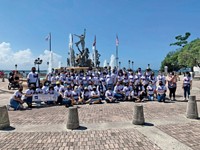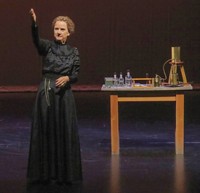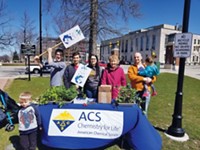Advertisement
Grab your lab coat. Let's get started
Welcome!
Welcome!
Create an account below to get 6 C&EN articles per month, receive newsletters and more - all free.
It seems this is your first time logging in online. Please enter the following information to continue.
As an ACS member you automatically get access to this site. All we need is few more details to create your reading experience.
Not you? Sign in with a different account.
Not you? Sign in with a different account.
ERROR 1
ERROR 1
ERROR 2
ERROR 2
ERROR 2
ERROR 2
ERROR 2
Password and Confirm password must match.
If you have an ACS member number, please enter it here so we can link this account to your membership. (optional)
ERROR 2
ACS values your privacy. By submitting your information, you are gaining access to C&EN and subscribing to our weekly newsletter. We use the information you provide to make your reading experience better, and we will never sell your data to third party members.
Education
Candy-Coated Chemistry
National Chemistry Week satisfies the public’s sweet tooth with activities from coast to coast
by Linda Wang
December 15, 2014
| A version of this story appeared in
Volume 92, Issue 50

If the goal of National Chemistry Week (NCW) this year was to sweeten the public’s perception of chemistry, it surely succeeded.
NCW is the American Chemical Society’s largest annual outreach event, and during Oct. 19–25, volunteers from the American Chemical Society’s 186 local sections came out in force to lead hands-on activities and demonstrations at museums, shopping malls, libraries, and other public venues around the U.S. and in Puerto Rico.
NCW’s mission is to educate members of the public about the importance of chemistry in their daily lives, ACS President Tom Barton says. “We all owe a great debt to those who volunteer their time to get this message out,” he says.
This year’s NCW theme, “The Sweet Side of Chemistry—Candy,” was especially easy for kids to relate to, says George Heard, chair of the ACS Committee on Community Activities, which coordinates NCW with the help of the ACS Office of Volunteer Support. “Everyone knows what candy is, but have you really thought about the chemistry of candy and the fun things you can do with candy?”
Local sections incorporated the candy theme into hands-on activities and demonstrations that included floating the letters off M&M’s and Skittles candies, exploding gummy bears, and analyzing the acidity of sour candies.
More than 139,000 copies of the NCW publication Celebrating Chemistry were distributed in English, and another 16,000 were given out in Spanish. The publication featured activity ideas, as well as food for thought on the chemistry of candy and confections.


The NCW community event rallied local sections around a charitable cause, which this year was to collect and donate leftover Halloween candy to families in need. To tap into children’s imaginations, the NCW Illustrated Poem Contest gave students in grades K–12 a chance to interpret this year’s theme. Winning entries are featured in an online supplement to this article.
NCW started in 1987 as National Chemistry Day. By 1989, many local sections were doing a full week of chemistry activities, and in 1993, the event was renamed National Chemistry Week.
“When this event first began several decades ago, no one could have imagined how widespread it would become and how successful it would be today,” ACS Executive Director and Chief Executive Officer Madeleine Jacobs says. “National Chemistry Week is the embodiment of volunteerism at ACS; it involves thousands of ACS members engaging with the public in a way that no other activity of ACS does.”
“I love seeing the creativity of volunteers and coordinators putting together events that really reach the public,” Heard says. “There are small events, and there are big events, all to get people talking and thinking about chemistry.”
Heard notes that, as a chemist, volunteering for NCW activities has given him a unique opportunity to connect with the public. “I get to meet families, I get to meet high school teachers, I get to meet informal educators, I get to meet members of the community, and I get to share ideas with them,” he says.


As fun and lighthearted as NCW activities are, safety should be everyone’s number one priority, Heard says. “Every outreach activity that we promote has been through a safety review, and we encourage local sections to conduct their outreach events in a safe and fun manner.”
ACS Board Chair William F. Carroll Jr. encourages everyone to extend NCW all year long. “We celebrate NCW every time we talk basic science to a kid, or when we speak simply and enthusiastically to a neighbor about what we do,” he says. “We might focus on one week, but NCW lives whenever chemists are jazzed about what they do.”
Jacobs reiterates NCW’s purpose: “I’d like members of the public who take part in an NCW activity to know that chemistry is everywhere in their life, that it is important to their daily standard of living, and that it is fun.”
The following is a tasty sampling of some of the hands-on activities and demonstrations that took place around the country this fall.
In Vermont, the Green Mountain Local Section hosted a day of candy-themed activities and chemical demonstrations at Burlington Town Center shopping mall. The event, organized by the ACS student chapter at Saint Michael’s College, included hourly chemical magic shows.

The Northeastern Section celebrated NCW with events at the Boston Children’s Museum and the Museum of Science, in Boston. ACS Past-President and University of Wisconsin, Madison, chemistry professor Bassam Z. Shakhashiri captivated the audience at the Museum of Science with his Phyllis A. Brauner Memorial Lecture. The local section also organized a Wicked Sweet Science Café, hosted by the Cape Cod & Islands Council of the Boy Scouts of America.
Farther west, in the Northern New York Local Section, fifth- and sixth-graders from St. Mary’s School, in Canton, were treated to a special presentation by Dana M. Barry of Clarkson University, who explained the chemical makeup of candy and shared her favorite candy recipes. Elsewhere in the local section, Clarkson’s Richard E. Partch presented his research on nanoparticles at area high schools and universities. In addition, the section held its annual Chemtoberfest at SUNY Potsdam, complete with a food science magic show.

On Oct. 18, the Eastern New York Section engaged more than 500 children and 300 parents in hands-on activities at the New York State Museum, in Albany. Volunteers from industry, academia, and government staffed 15 activity stations where children made rock candy, performed M&M color separation experiments, learned about the chemistry of chewing gum, and expanded marshmallows using a vacuum. Participants were also treated to a chemistry magic show sponsored by General Electric.
More than 280 volunteers helped the New York Local Section host outreach activities at the New York Hall of Science, in Queens. More than 1,000 visitors enjoyed free admission to the museum, where they rotated through 30 activity tables. As in previous years, Mr. Met, the official mascot of the New York Mets baseball team, made a special appearance and took photos with visitors. In addition, the section dedicated the New York Hall of Science as a New York Historic Chemical Landmark.

In New Jersey, the North Jersey Section held its 20th ChemExpo at the Liberty Science Center, in Jersey City. The event attracted more than 800 visitors, who were treated to hands-on activities by 250 students and volunteers from academia and industry. In addition, 10 ACS student chapters from area colleges participated in the fifth annual Sister Marian José Smith Undergraduate Outreach Competition.
On Oct. 24, the Princeton Section held Candy Activities Night at Princeton University’s Frick Chemistry Laboratory. Kids tested sweet and sour candies, made designs using dyes from Rainbow Nerds candies, compared the density of different candies, and investigated osmosis in gummy bears. Pattie Robinson of local business Robinson’s Chocolates gave several talks and demonstrations on chocolate.
In Pennsylvania, the Pittsburgh Section hosted ChemFest, a two-day outreach event at Carnegie Science Center. More than 4,000 people attended the event, which was staffed by nearly 300 volunteers. In addition, high school students participated in a ChemFest Career Café activity, where they chatted with industry professionals.
The Chemical Society of Washington hosted a number of NCW activities in the nation’s capital. On Oct. 18, volunteers from the local section joined ACS staff for hands-on activities at John Eaton Elementary School in Washington, D.C. On Oct. 26, volunteers from the local section participated in the Family Fun Festival, in Arlington, Va., which was held in conjunction with the Marine Corps Marathon.
Highlights of the Northern West Virginia Local Section’s NCW celebration included periodic table cupcakes at West Virginia University, science activities during a Haunted Holler event at a local Girl Scouts camp, chemistry demonstrations at West Virginia Wesleyan College, and Mole Day activities at Fairmont State University.

The Eastern North Carolina Section took part in the Cape Fear Museum’s Science Spooktacular event. Children made litmus paper using radishes and red cabbage juice and tested the pH of different household materials. They also tested the acidity of different candies by crushing them up and adding them to an aqueous solution of baking soda. Volunteers came from the local section; the University of North Carolina, Wilmington; and Cape Fear Community College, in Wilmington.
In the East Tennessee Section, University of Tennessee, Knoxville, chemistry professor Al Hazari delighted the audience with his 24th annual chemistry magic show. Hazari also put on demonstrations at the HoLa Festival in downtown Knoxville and during a homecoming event at the university. Members of chemistry clubs put on presentations and displays at local four-year and community colleges. In addition, both the governor of Tennessee and mayor of Knoxville signed proclamations honoring NCW.
The Louisville Local Section hosted a three-day celebration for 1,700 people at the Kentucky Science Center in downtown Louisville. Activities included floating the letters off Skittles candies and testing the acidity of sour candies.
As part of the Northeast Tennessee Local Section’s celebration, Eastman Chemical’s Toy F. Reid Employee Center hosted its Celebration of Chemistry for 4th Graders event. Roughly 1,400 fourth-graders from 25 schools in northeastern Tennessee and southwestern Virginia attended the event. They made plastic fossils and learned about fluorescence. The local fire department treated students to a presentation on the chemistry of firefighting.


On Mole Day, Oct. 23, the Kentucky Lake Local Section hosted a day of outreach activities at the University of Tennessee, Martin. ACS student members from UT Martin, Union University, Bethel University, and Murray State University put on demonstrations for more than 200 adults and children.
The Kalamazoo Section hosted Chemistry Day at Kalamazoo Valley Museum, in Michigan. More than 50 volunteers presented 25 hands-on activities for 800 visitors. Highlights included a chemical volcano and a geyser created by dropping Mentos candy into a bottle of soda.
In the southern part of the country, more than 1,100 students in grades K–12 and their parents enjoyed hands-on activities during the Baton Rouge Local Section’s annual Super Science Saturday event, held at Louisiana State University (LSU) on Oct. 11. This was the section’s biggest turnout in 27 years of doing this outreach event. More than 150 volunteers from local companies, organizations, and colleges engaged participants at 20 activity stations. The event was sponsored by the local section, the LSU department of chemistry, and LSU athletics.
The Greater Houston Section reached more than 400 children with its outreach event at the Children’s Museum of Houston. Volunteers were from the University of Houston, San Jacinto College, the University of St. Thomas, and Houston Baptist University.
More than 3,000 people attended the Texas A&M Local Section’s annual Chemistry Open House & Science Exploration Gallery at Texas A&M University. The free event, held on Oct. 25, featured a Chemistry Road Show, tours of research labs, hands-on activities, chemistry lectures by Texas A&M chemistry faculty, door prizes, and science goodie bags.
SWEET TWEETS
Can’t get enough of National Chemistry Week? Here’s a sampling of what people were sharing on the social media site Twitter during the NCW celebrations.
The Tampa Bay Local Section got into the candy theme with activities such as floating the letters off M&M’s, predicting the density of candies, and using both baking soda and red cabbage indicators to determine the relative acidities of sour candies. The activities were held in the lobby of the Museum of Science & Industry, in Tampa. Approximately 400 students and their parents participated in the event, and visitors left with an ACS activity booklet and a bag of M&M’s to experiment with at home.
On the West Coast, the Orange County Local Section held its Chemistry Day celebration at the Santa Ana Zoo. Nearly 2,000 people attended the Oct. 12 event, and residents of Santa Ana received free admission to the zoo. As in previous years, Rudy Gonzales, also known as “Mr. Chemistry,” put on his popular Rudy’s Radical Science Show.
Elsewhere in California, the San Joaquin Valley Local Section challenged students to find candy chemistry facts hidden by ACS “moles” around the campus of California State University, Fresno. Students were encouraged to take a selfie with each mole and post their photos to Facebook and Twitter. Other activities included a Kiss-a-Pig contest, a haunted house hosted by the Fresno State Chemistry Club, and a wine and cheese social at the Agriculture & Priority Pollutants Laboratories, in Clovis.
Advertisement
As part of the Sacramento Section’s activities, members of the Sacramento City College Chemistry Club visited students at Da Vinci Junior High School, in Davis, Calif., and helped them make foldable spectrometers.
In the California Section, more than 100 Girl Scouts, along with their troop leaders and parents, kicked off NCW on Oct. 19 at Golden West Middle School, in Fairfield. The students rotated through seven hands-on activity stations where candy was used to demonstrate various chemistry principles. On Oct. 22, the Scientific Jam band kicked off Family Science Night at Helms Middle School, in San Pablo. The local section also participated in outreach activities at the Bay Area Science Festival held in San Francisco on Nov. 1.
Up north, the Richland Section organized its 13th annual Girls in Science event at Eastern Oregon University, in La Grande. Girls were asked to use their chemistry knowledge to solve the mysterious death of Dracula at a Halloween party. One of the experiments involved determining the melting point of different types of chocolates.
In the Puget Sound Section, the Pacific Lutheran University chemistry department and the ACS student chapter hosted its annual Mole Day Eve Spooktacular. Highlights of the event included a periodic table of brownies, a demonstration on making caramel, and a chemistry show capped by a thermite jack-o’-lantern grand finale.
On Oct. 26, the Puerto Rico Section hosted its annual Festival de Química at Paseo de la Princesa, in San Juan. More than 500 volunteers from 14 ACS student chapters from Puerto Rico, 14 ChemClubs, the section’s Younger Chemists Committee, the Puerto Rico Chemists Association, the Puerto Rico Nutritionist Association, and the American Association for the Advancement of Science’s Caribbean Division engaged 3,000 kids and the general public in hands-on activities.
Finally, despite the threat of Hurricane Ana on Oct. 18, the Hawaii Local Section hosted a successful day of outreach activities at Kahala Mall, in Honolulu. The event, cosponsored by the chemistry section of the Hawaii Science Teachers Association, featured 13 tables of hands-on activities and demonstrations. Visitors were also treated to homemade cotton candy.
Plans are already under way for NCW 2015, which will take place on Oct. 18–24, 2015. The theme, “Chemistry Colors Our World!” will explore the chemistry of dyes, pigments, and light.





Join the conversation
Contact the reporter
Submit a Letter to the Editor for publication
Engage with us on Twitter